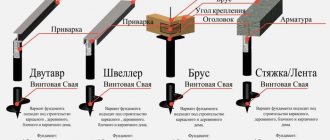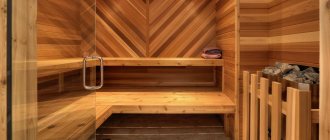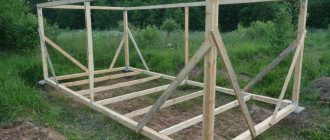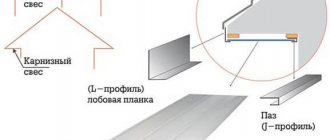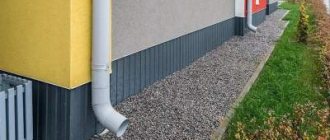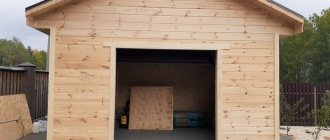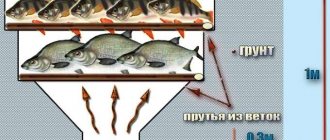A pile foundation is an opportunity to build buildings on soils that do not allow the use of any other type of supporting structure.
A feature of piles is their ability to sink to the required depth, reach dense layers of soil and provide a reliable foundation for buildings of any category, including the most massive, critical and specific ones.
The possibilities of a pile foundation are very wide, which is clearly demonstrated by the number of varieties and design options for supports.
There are powerful and heavy samples that can only be worked with using construction equipment.
There are also lighter types available for self-installation, for example, screw piles.
Types of pile foundations
The classification of pile foundations includes many positions.
They differ in the following characteristics:
- Method of action (hanging and pile-racks).
- Barrel type (monolithic and shell)
- Material (wooden, metal, reinforced concrete)
- Immersion method (driving, bored or screw).
NOTE!
In private housing construction, the most common are bored and pile-screw options, which allow working in densely built-up areas without causing damage to surrounding buildings.
Briefly about the main thing
Screw piles consist of a shaft with a sharp tip and a screw. They are made from durable steel and are protected from corrosion by special compounds. In the factory, control is carried out over the manufacturing process, the quality of the materials used and the compliance of finished products with SNiP requirements. It is impossible to recreate the production process at home, since screw piles in this case are made from materials that can be processed manually, that is, less durable. Such products can only be used for the construction of light buildings. They are made from steel pipes, sharpening their lower cut and welding a sheet steel screw to it.
| Additionally The exhibition of houses “Low-Rise Country” expresses sincere gratitude to the specialists for their assistance in creating the material. (Royal Pile Factory) – expert in pile foundations. If you need more detailed advice, you can use the following contacts: website: kzs.ru email: tel.: 8-800-222-76-17 |
Ratings 0
Read later
Types of piles
Screw piles have two main types:
- Welded.
- Cast.
The difference between them is the design of the tip. This is an important element that takes on the main load during a dive.
The quality of the tip determines how the pile will behave when it comes into contact with a man-made or natural obstacle that is not a dense soil layer. Welded tips are less durable in this regard; when encountering rock fragments, they are often deformed and fail.
The cast tip is much stronger and is able to pass obstacles, destroying them and without losing the functionality of the pile.
In addition, there are differences in the number of blades.
There are screw piles:
- Single bladed.
- Multi-lobed.
Single-blade piles have a single spiral-shaped blade that provides translational motion as the pile rotates around a vertical axis. They are designed for installation in relatively soft and homogeneous soil that does not have dense or rocky inclusions.
The bearing capacity of such piles is lower than that of multi-bladed samples, which are much more stable and more firmly connected to the ground. The presence of several support units makes it possible to reduce the diameter of the barrel, which facilitates installation and ensures structural integrity.
Complete with a cast tip, they are optimally suited for working on dense soils, in permafrost zones or with a large number of man-made inclusions.
Based on the type of protective coating, piles are divided into galvanized and non-galvanized . The latter are practically not protected in any way from the effects of ground moisture, since the layer of paint, which is applied to give the products greater solidity, comes off when screwed.
In addition, all types of screw piles are practically not protected from electrochemical corrosion or the effects of stray currents, which is difficult to foresee or determine in advance.
Determining the length and diameter of the pile
When planning to build a strip foundation on screw piles, you should determine the length of the spiral support and the diameter of its working part. With correctly selected characteristics of screw supports, a pile-screw foundation has a high load capacity and is as reliable as a tisse foundation.
The load capacity of supports with a spiral working part depends on the size of the contact area and is determined by the following operating parameters:
- the length of the screw winding and the entire pile;
- outer diameter of the spiral tape.
The load capacity of supports with a spiral working part depends on the size of the contact area.
The overall dimensions of the working part of spiral-screw supports are determined depending on the following factors:
- soil characteristics at the construction site;
- soil freezing depth;
- concentration of mineral impurities in the soil;
- level of location of solid layers;
- soil resistance to screwing in the support;
- mass of the structure being built.
The length of the pile varies depending on operating conditions:
- supports with a length of 1-1.2 m are installed in areas with a warm climate;
- for the middle strip, one and a half meter supports are suitable;
- piles longer than 2 m are installed in the northern regions.
The diameter of the helical winding is determined by the load acting on the support, transmitted by the structures being erected:
- for lightweight and fencing structures, piles with an outer tape diameter of 5-8 cm are used;
- the stability of frame and wooden buildings is ensured by blade supports with a diameter of 9-9.5 cm;
- the reliability of massive buildings is ensured by reinforced piles with an outer coil diameter of more than 10 cm.
The load acting on the support determines the diameter of the helical winding.
The load characteristics increase in proportion to the increase in the outer diameter of the helical winding:
- a spiral-screw element with a support pipe diameter of 7.6 cm and an external coil size of 20 cm is capable of carrying up to a ton of payload;
- with an increase in the diameter of the barrel to 9 cm, as well as the diameter of the screw tape to 25 cm, the load capacity increases by 2 times and reaches 2 tons;
- piles made from pipes with a cross-section of 10.8 cm and a spiral diameter of 30 cm are capable of withstanding a force of 2.5 tons.
Reinforced screw piles, used for the construction of foundations for massive buildings, are capable of bearing loads of over 3 tons.
Which ones are best suited for private construction?
The choice of a specific brand and size of trunks is, first of all, made based on the type and characteristics of the soil.
After determining the most suitable variety (single or multi-bladed, length, tip type), the trunk diameter is selected. The calculation is made based on the bearing capacity of the support.
For private houses, trunks of relatively small diameter are usually used:
- VS-57.
- VS-76.
- VS-89.
- VS-108.
Large diameters require significant effort when immersing, so they are practically not used for private housing construction.
Calculation of the mass of the house
Calculate the total weight of all construction and finishing materials that will be used during construction. The estimated maximum weight of furniture, household items, and people who will be in the house are taken into account. Calculate the mass of the bathtub or pool, taking into account that the tank will be filled with water.
Take into account the load of the snow layer that may lie on the roof in winter. This indicator is calculated on the map depending on the region:
What soils are they suitable for?
The screw piles are driven to a sufficient depth to eliminate the impact of vertical loads of frost heaving. Only lateral influences remain, which, due to the small contact area, are not capable of exerting a decisive influence on the supports.
Therefore, when determining the suitability of a soil, it is customary to consider only mechanical qualities.
The most suitable types are the following types of soil (in descending order of suitability)::
- Sandy.
- Sandy loam.
- Loams.
- Clayey.
Absolutely unsuitable soils are rocky and rocky-clastic types. In addition, biogenic types - peat bogs, or loose subsidence soils - are contraindicated.
Caution should be exercised in heavily flooded areas subject to strong seasonal fluctuations in groundwater levels..
When constructing in such areas, it is necessary to carry out test drilling and increase the immersion depth to the maximum.
General scheme for installing a pile-screw foundation
Step-by-step instructions for installing piles with your own hands consists of the following steps:
- Preparatory work. Marking the site, checking the parallelism of the lines and compliance with right angles.
- Immersion of corner shafts.
- Installation of intermediate supports.
- Trimming trunks. The surface of the supports should form a flat horizontal plane.
- Concreting the internal cavities of piles to enhance strength.
- Installation of heads. They are installed on the upper end, welded and serve as attachment points for the grillage. All areas located near the weld or areas with damaged protective coating are immediately touched up.
IMPORTANT!
When marking, you should proceed from the axes of the walls, and not from the boundaries of the perimeter of the house. Walls should stand on the heads and not hang from them.
How to calculate the amount of material?
The number of supports is calculated in two directions:
- Along the lines of the greatest load.
- According to the bearing capacity of the pile.
The first stage consists of counting the number of piles along all lines of the external and internal load-bearing walls. The distance between them should not exceed 2-3 m (the heavier the house, the closer to each other the supports should be installed).
The second stage is to check the resulting number of supports. The total weight of the house, together with the calculated additional loads (the weight of snow, furniture and household appliances, floors, people, etc.) must be divided by the permissible load on one pile.
If the resulting number is less than what was found in the first stage, then the calculation is correct. If the second stage shows a higher value, it is necessary to increase the number of piles along the load lines.
You can do it easier and use an online calculator, which will do the entire calculation on its own. You just need to insert your parameters into the required fields and get an answer.
How to correctly mark installation locations?
To perform this operation, you will need a plan of the first floor of the house. First, corner points and junctions of load-bearing walls, internal and external, are marked. Then the remaining number of piles is evenly distributed along all lines.
If there are large gaps, provide intermediate supports to support the floor beams.
NOTE!
A distance of more than 6 meters between supports is considered unacceptable.
How to determine diving depth?
Determining the immersion depth of the supports can only be done on the basis of an analysis of the soil and its composition. In addition, an important factor is the depth of soil freezing, above which it is not recommended to bury piles, especially for critical (residential) buildings.
For auxiliary buildings and structures (gazebos, fences, sheds, etc.) erected on suitable soils, the minimum immersion depth is 1.5 m.
For residential buildings, the recommended immersion depth should be equal to the height of the house . In practice, it is often less, which is primarily due to illiteracy or the desire to reduce builders’ time.
When diving, you must know the maximum value of soil resistance and not exceed the permissible limits established by the manufacturer. Otherwise, there is a risk of collapsing the technological hole before reaching the required depth, which means the pile will be damaged and will need to be replaced.
Immersion of piles into the soil
There are two ways to drive piles:
- Manual diving.
- Mechanical method.
Manual installation is allowed only for relatively thin piles and during the construction of non-critical auxiliary structures. For residential buildings it is necessary to use construction equipment . First of all, this is due to the inability to properly screw in a pile with a diameter of 108 mm by hand.
The failure rate of piles is too high, and reverse is unacceptable due to the loss of proper connection strength. In addition, the permissible vertical skew of the barrel is only 2°, which is impossible to ensure manually.
The mechanical method allows you to ensure high-quality immersion while maintaining the vertical and a given amount of force . For residential buildings, only the mechanical method is permissible, although advertisements in every possible way claim that it is possible to act in any situation with the help of muscular force.
This creates the opportunity for various violations when inexperienced builders begin to act on their own and, as a result, end up with an unstable and moving foundation. In practice, a mini-excavator with a mounted pile driver is usually used.
It is capable of immersing trunks with a diameter of up to 159 mm to a depth of up to 12 m, which in most cases is quite sufficient for private construction.
How to align horizontally
Submerged screw piles must be leveled horizontally. To do this, install a laser building level (you need a model that can outline a horizontal plane) at the required height from the soil surface.
All trunks are trimmed according to the existing mark . If any of them are too short, a preliminary extension is made.
An additional pipe is welded to the trimmed part of the trunk (the section with the technological hole is cut off), increasing the missing length, after which trimming is performed at the general level.
All welds and areas of metal exposed during trimming must be immediately tinted with protective polymer paint. It is necessary to choose types that are impervious to moisture or use bitumen mastic.
Pouring concrete
The internal cavities of the piles are filled with concrete. This allows you to significantly increase the mechanical rigidity of the pipe and reduce the risk of corrosion inside the barrel.
Concreting increases the load-bearing capacity of the trunk by a third, allowing you to obtain a certain margin of strength for the foundation, necessary for resistance to unforeseen situations . For pouring, dense grades of concrete are used - M200 and higher. Filling is done to a level slightly lower than the cutting height.
In the first hours, the concrete in the well will sag by several centimeters, so after filling, a dry sand-cement mixture is poured to the top of the shaft. It will absorb water particles squeezed out during subsidence and form a plug that seals the barrel before installing the head.
Methods suitable for self-installation
Once you have decided to install a house or other structure on point supports, it makes sense to figure out how to screw in screw piles yourself, even if hired people do the work. At a minimum, they need to be controlled, and for this you need to be comprehensively savvy.
Method 1
Before installing the first screw pile, preliminary marking of all support points does not need to be done, since there will still be discrepancies. The first and second (on the opposite corner) piles will serve as beacons for forming a pile field, between which the mooring cord can be pulled:
- To screw in a pile with your own hands, without the use of special equipment, first make a small pit at the installation point and add water there so that the soil softens.
Preparing the hole before tightening the piles with your own hands Source bibliostroy.ru
- The pile is installed in the hole, and a steel mounting scrap is inserted into the technological hole at the top of its shaft. You can do this yourself, but to tighten screw piles without a special machine, you will definitely need two assistants - one will hold the pile in a given position, and two more people will ensure movement in a circle.
Preparing the pile for screwing Source bibliostroy.ru
- Rotation will be carried out by acting on a pipe placed on a crowbar - it will serve as a lever transmitting a turning force to the barrel. The larger the lever, the easier it will be to turn. To make it easier to rotate, you need to try to lower the pipes down, for which you will have to bend the crowbar a little.
Installation of levers Source bibliostroy.ru
- Holding onto the pipes, two people begin to rotate, and the one who holds the trunk controls the verticality of the trunk in terms of level. In this case, a double-sided magnetic device attached directly to the barrel is used for this purpose. But you can get by with the regular level, although it is not as convenient. The vertical is set after the initial drilling - after the pile catches on the ground.
How to tighten and level screw piles manually - using a double-sided magnetic level Source bibliostroy.ru
Grillage strapping
A grillage is a strapping belt that connects individual supports into a single system. It is needed to bear the weight of walls or other structural elements of the house and distribute the load evenly across the entire pile field.
There are different methods for installing a grillage, depending on the material of manufacture.:
Wood
A wooden beam with a minimum thickness of 150:150 mm is used. As an option, you can use packs of boards 50 mm thick and 200 mm wide, connected into a single package measuring 150: 200 mm. High-quality dry lumber of grade 1 or 2 is used.
The surface of the wood is coated with an antiseptic and fire-retardant composition (currently there is an impregnation that performs both functions). The connection of the beams is made halfway across the tree and only above the head of the pile.
Joints located in the span are not allowed. A double layer of roofing material (waterproofing) is laid between the metal and wood in all places. The installation is carried out so that the pile is located exactly along the longitudinal axis of the beam.
Metal
Various types of rolled metal are used:
- Channel.
- I-beam
- Rectangular pipe.
When using a channel, no heads are needed, although their presence is required for a pipe or I-beam. For the channel, special embedded parts are used, installed in the pipe when pouring concrete.
It becomes possible to do without waterproofing between the heads and the trim, but between the metal and the wall it is used in any case . The parts are connected by welding with mandatory reinforcement with bolts.
With increased strength of the metal grillage, a large metal structural element appears that requires maintenance - periodic painting with protective compounds.
Reinforced concrete
This is the most labor-intensive and time-consuming option for creating a grillage, but also the most durable and reliable, not subject to corrosion or rotting. To create it, it is necessary to make formwork installed on top of the heads.
A reinforcement cage is placed inside, after which they begin pouring concrete.
The inside of the formwork is covered with a layer of roofing felt or polyethylene to prevent moisture leaks. Sometimes the grillage is poured below the level of the caps, welding the reinforcement cage directly to the trunks. Most often this is done at a sufficient height at ground level.
In such cases, horizontal trimming is carried out after the concrete has hardened (28 days), and the filling of the trunks is carried out after trimming.
Video description
The following video shows in detail the screw manufacturing process:
The finished blade is welded to the end of the pile, trying to ensure that the plane of the screw is perpendicular to the trunk. Apply a suture on both sides, without gaps. The strength of the entire structure depends on its reliability.
Final processing
After completing the welding work, remove scale from the seams and grind them thoroughly. Then the entire product is cleaned of rust, degreased and an anti-corrosion coating is applied. This can be a high-quality metal primer or ship paint. They should be applied in at least two layers, allowing each to dry before applying the next.
Paint will protect metal products from corrosion Source i.ytimg.com
How to make a false base
The false base is designed to protect the space of the pile field under the house from the penetration of animals or birds, snow sweeping in winter, from wind and moisture. To create such a base, various materials are used.
The most budget-friendly and aesthetically attractive option is a strip of corrugated board along the outer perimeter. It is attached at the top to a special wooden board installed around the perimeter of the grillage.
The lower part is attached to a wooden beam laid on stands made of brick, cinder block, etc. to cut off contact with the ground .
A concrete ebb should be installed along the lower edge, and an ebb should be installed along the upper edge to drain rainwater.
Video description
How to prepare concrete and how to pour piles under the foundation with your own hands is shown in the video:
After the concrete hardens, caps are welded onto the piles - metal platforms on which the grillage will be attached. There are two ways to do this.
- Weld triangular gussets to the end of the pipe on four sides, and secure the pads to them by welding.
- Make heads from scraps of pipe of larger diameter, put them on the ends of the piles and weld them in a circle.
Overhead heads with a platform drilled for fasteners Source svai-kirov.ru
